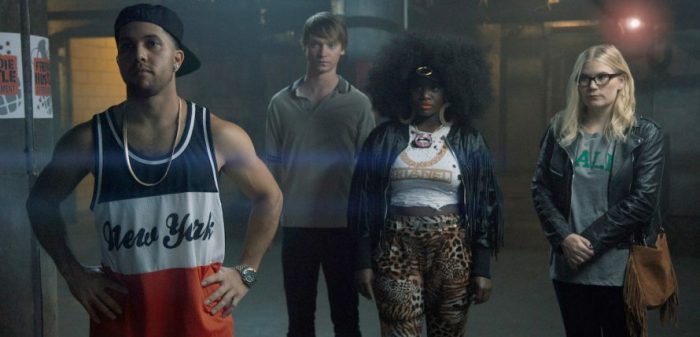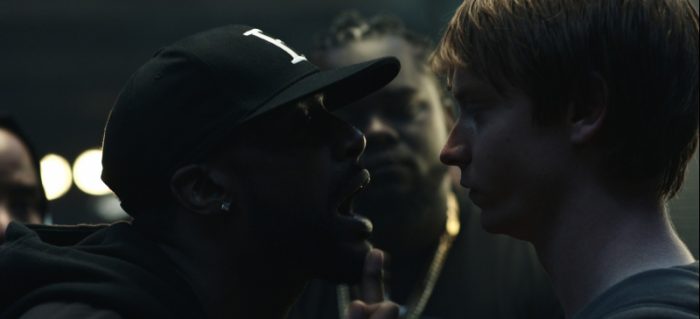Grappling With ‘Bodied’, 2018’s Most Brazen, Entertaining, and Troubling Movie

Joseph Kahn’s Bodied, which made its way around the festival circuit last fall, is finally here, though it enters a world that feels even more volatile than the one it was meant to critique. Born out of the polarized reactions to Kahn’s “Wildest Dreams” music video for Taylor Swift — which came under fire for centering whiteness in the Serengeti on a fictional ’50s film set — the adrenaline-fueled satire follows white academic Adam Merkin (Callum Worthy, American Vandal) as he enters (and eventually, dominates) the world of underground rap battles. It’s a wildly entertaining movie, one that draws laughs and gasps and applause in equal measure, and it’s best watched with an audience with whom one can experience its thrills and debate their appropriateness after.
“Words. Are. Weapons,” a phrase spoken early on in the film’s first teaser, may as well be its mantra. It understands the power and the beauty of words, but it also understands their ugliness, and how these categories can shift and overlap depending on context. Its spoken dialogue is as poetic as its battle verses, and its visual palette is just as energetic (both feature Dostoevsky references, too!) though in an era where ugly words can galvanize entire hate movements into action, one wonders just how much fun can be had while exploring their power in a satirical setting. For my money, it’s worth the time, but as the film goes on to explore: we are all, each and every one of us, going to have a different approach to art.

A Year in the Life of Bodied
The film’s premise alone, the ascension of a white artist in a traditionally Black space (in a film produced by Eminem and written by white Canadian rapper Kid Twist) feels like an open-ended question, one that might instinctually rub you the wrong way depending on who you are, but it might also compel you to look into its context just a little bit further. That is, in essence, what the film is about in the first place. It introduces us to a world of characters built equally of stereotypes, anti-stereotypes and lived experiences, placing them all within an artistic space that demands they be taken to task — both for their art, and by the art of others. Both by the audience, and by their peers. Both for ignoring context, and for being so presumptions as to establish it in the first place.
By Kahn’s own account, the reactions to his “Wildest Dreams” video varied from valid critiques of how we view cinema history as it pertains to race, to more ludicrous accusations that he supports Apartheid. “The conversation,” as one might call it — on appropriation, on political correctness, or simply on the role of art in a frayed political climate — is fractured in our online era, veering off in innumerable directions lest a new issue arise and the opportunity for immediate critique be lost. The turnaround time rarely allows for thoughtful consideration, and chances are, the discourse around Bodied may fall victim to the more accelerated part of online culture too.
Or, it may not.
In fact, we may not have the time or the emotional energy to talk about it at all, given everything that’s happened these last few weeks. From the rise of fascism in Brazil, to at least three different perpetrators of domestic terror in America, to the Trump administration taking its first steps to ending birthright citizenship and suppressing trans identity, it would appear a desire to inject nuance into conversation around identity politics or “political correctness” (rather than rejecting the idea that they ought to be debated) no longer feels as appropriate as it did last September, when I watched and reviewed the film.
“Political correctness” can, after all, be a synonym for respecting someone’s basic humanity. As much as Megyn Kelly might like you to think, avoiding blackface isn’t ruining your Halloween. The film however, asks when it might be acceptable to hurl politically-charged insults about one’s identity (or make politically charged art in which offense is a byproduct) in the very same vein of those who seek to dehumanize. Adam’s self-awareness as a rapper and his clearly put-on bravado become part and parcel of his rapper persona, but despite his “ironic” approach to bigotry, the question remains: when is it okay to cross the lines drawn by polite society?
While the conclusion the film comes to is along the lines of “when both parties deem it acceptable” (before introducing complications to that same answer as the circle of participants widens) the film strikes a nerve that was already raw in 2017, one that only grows more so. Must we, at this point in our history, have this specific debate about when it might be okay to dehumanize someone based on race or gender? As excited as I’ve been for the film’s public release, I wouldn’t hold it against anyone if they decided now wasn’t the time to engage with it, despite it being one of the most raucous and entertaining audience experiences I’ve ever seen. (If it sounds like your cup of tea, do watch it with a crowd). And yet, engage with it we must if we choose to watch it, given that it demands we do battle with the cultural context of offensive art in the first place. As much as we might want to hit pause on this conversation, we’re still constantly producing and consuming political art, perhaps even quicker than before.
An American Vandal
I love Adam Merkin. I love the sleaziness with which Callum Worthy portrays him, and how he hides behind a puppy-dog stare until it’s time to bite. As a character, Adam is an honest embodiment of an occasionally dishonest perspective, a white liberal for whom racism is a no-go until it isn’t. As a person, he’s someone I would never want to hang out with, which makes him all the more successful as a fictional construct. The film wants to have an uneasy conversation around art, and forcing the viewer to spend time with the worst parts of not just a person, but an argument, is an effective approach.
Adam opens the film with his girlfriend Maya (Rory Uphold), who he’s dragged to a battle-rap event as research for his thesis. As two upper-middle-class white academics in this largely Black (although increasingly Asian and Latinx) space, they stick out sorely. However Adam, a white kid researching the use of the N-word in Hip Hop for his senior paper, sticks out even further despite being the more enthusiastic of the two because of the questions he’s asking.
Maya, a white vegan feminist who rolls her eyes at the event’s misogynist lyrics, represents an argument too. She refuses to engage with Hip Hop, period, but rather than representing opposing ends of a scale, she and Adam are just two of an infinite number of points on a vast cultural spectrum. Where Maya refuses to engage, Adam is eager to do so, but they both lack the necessary cultural context for either course of action. They’re privileged outsiders who think they have the ultimate say, playing in to larger dynamics they each try and use against the other. Maya accuses Adam of appropriating Black culture; Adam turns the tables by calling her disdain for the art-form colonialist.
If they sound insufferable, that’s because they are. They each use the language of social justice and online “devil’s advocate” whataboutism without the life experience that would make their claims authentic. For them, the most potent parts of this conversation are a kind of social or socio-political currency — or perhaps, a game of one upmanship not dissimilar from battle rap itself. And yet, Kahn isn’t satisfied only with satirizing only these two warring perspectives.
Continue Reading Bodied >>
The post Grappling With ‘Bodied’, 2018’s Most Brazen, Entertaining, and Troubling Movie appeared first on /Film.
from /Film https://ift.tt/2EYkLtA

No comments: